Bright Belt & Road stories amid COVID-19 pandemic
By Cao Siqi and Zhao Yusha in Wuhan Source: Global Times Published: 2020/11/23 18:23:40
Stories of hope from the Belt and Road during COVID-19
Twice-cooked pork, or hui guo rou, a Sichuan dish of spicy seared pork belly, may be quite familiar to Chinese people as an ordinary, delicious family dish. But to 27-year-old Mamun, from Dhaka, capital city of Bangladesh, the dish (especially cooked with beef) means much more.
Working in the office of the Chengdu Engineering Corporation Limited, one of subsidiaries of Chinese state-owned enterprise Power Construction Corporation of China in Bangladesh, under strict prevention and control measures to curb the spread of COVID-19, Mamun feels that the dish, cooked by his Chinese boss, warms his stomach, as well as his heart.
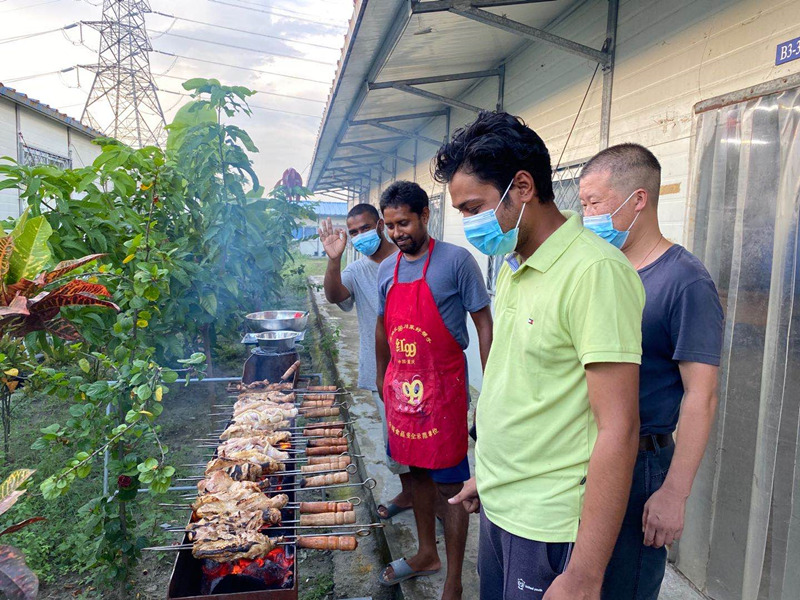
Mamun (left) makes barbecue with his colleagues in Dhaka, Bangladesh. Photo: Courtesy of Mamun
Bangladesh is still suffering from the raging COVID-19 pandemic and the country reported 2,275 new cases and 17 new deaths on Friday, bringing the tally to 443,434 cases and death toll to 6,322.
Under strict management, Mamun and his 380 Bangladeshi and 90 Chinese colleagues have to keep a social distance. For safety, they have shut the project camp's gate and usually have to wait a long time to get food dispatched by a local supplier to the project camp. After being disinfected for half an hour, these food materials can be sent to canteens for a second round of disinfection.
"I look ugly as I cannot go outside to get a haircut," Mamun joked. "These are really tough days. But Qin, my boss, often cooks his homemade cuisine - hui guo rou - for us. As we are Muslims, Qin considerately changed pork to beef. It not only tasted delicious, but also made me feel we are not only colleagues, but friends who work together to combat the virus and make the city better."
After graduation from college, Mamun sought his first job in this Chinese company which is constructing the largest sewage treatment plant in South Asia in the city of Dhaka. The project is part of the China-proposed Belt and Road initiative (BRI). Working in the communication management office, Mamun has witnessed how the project brought tremendous changes to his hometown and how the initiative benefits locals and improves their lives.
Mamun then decided to record a video of his daily life in the office. Entitled Hui Guo Rou on the Ganges, the one-minute video offers a glimpse into the lives of Chinese company staff participating in the Belt and Road construction, the friendship between Chinese and local workers and the courage they have demonstrated in fighting the health crisis together.
The video won an award during the second Belt and Road (BRI) short video competition held in Wuhan, in Central China's Hubei Province on Friday. By collecting short video stories from builders and beneficiaries from countries all along the Belt and Road, the competition aims to help build a community with a shared future for mankind.
Mamun's video is one of a total of 65 winners. Although the protagonists in the videos have different skin colors and cultural backgrounds, they showed common yearning for a better life and expectations for a better future. Their stories are just a microcosm of hundreds of thousands of people who are benefiting from the BRI and the initiative is gaining more and more recognition.
As the world is struck by the COVID-19 pandemic, industries have been suspended around the world, leaving many jobless. The deadly virus has hampered the BRI to an extent, but the initiative has not only been functioning well amid the ongoing crisis, but also played a significant role in the global anti-pandemic fight.
Twice cooked 'beef'
Bottles are floating on the river; trash could be seen everywhere in the city… this was what the city of Dhaka used to look like in Mamun's video. "Nearly 20 million people are living in Dhaka city. Those people produce so much wastewater. Since only an old sewage treatment plant built in 1978 is still running in Dhaka city, it's a big challenge for us to manage wastewater." Mamun told the Global Times on Friday.
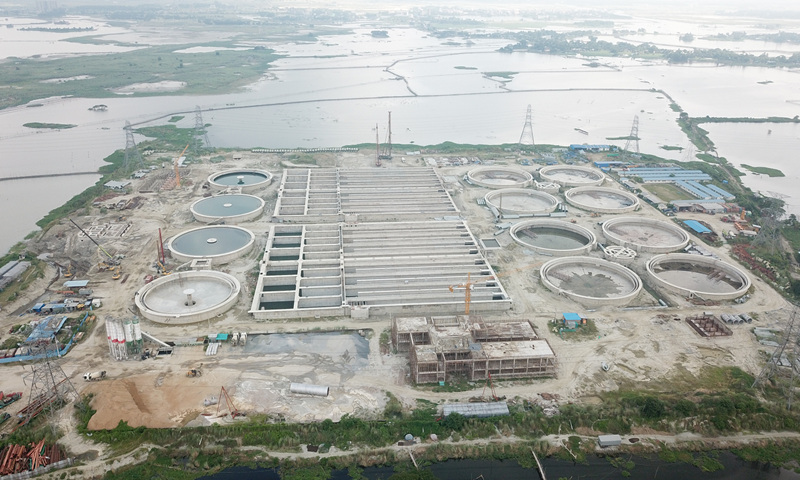
Chinese government-funded Dasherkandi Sewage Treatment Plant, the first modern treatment plant in Dhaka, Bangladesh Photo: Courtesy of Chengdu Engineering Corporation Limited
This Chinese government-funded project - Dasherkandi Sewage Treatment Plant, will be the first modern treatment plant in Bangladesh. After operation, the plant will obviously improve sewage treatment management in Dhaka and protect their environment and river.
The construction of the mega sewage treatment plant was started in 2018. The designed capacity of sewage treatment is 500,000 cubic meters per day. The project includes sewage lifting station (6 cubic meters per second), sewage conveyance pipeline and sewage treatment plant (500,000 cubic meters per day).
The Global Times learned from the Chinese company that the project had not only provided more than 1,000 jobs for local people, but also provided comprehensive technical training for Bangladeshi workers. The salaries of Bangladeshi workers are higher than the average for the country.
"Bangladesh is a highly densely populated country. We are facing many problems because of our limited resources. BRI improves our lifestyle, creates many jobs and improves our productivity. The initiative offers what we actually want," Mamun said.
Dream bridge
The 25 year-old Mahdi Hasan, another Bangladeshi worker in a Chinese company's office in the country, also won an award in the competition. Hasan is a bridge engineer of the China Railway Major Bridge Engineering Group. When he was young, he thought it would be great if there was a bridge beside his house as his hometown is full of rivers and it was very difficult for local residents to go to nearby cities. In the video, he tells a story about how the bridge makes life easier for Bangladeshi people and how he has realized his life values through working with Chinese engineers.
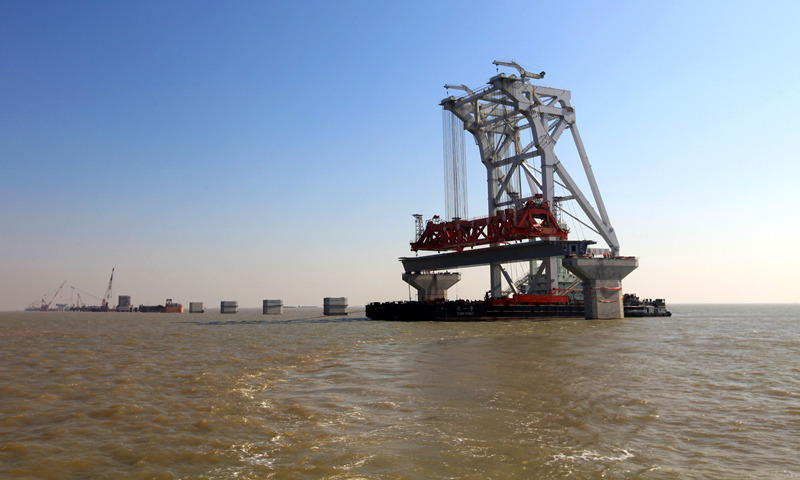
The China-funded Padma Bridge project in Bangladesh Photo: Courtesy of China Railway Major Bridge Engineering Group
The Padma River to the Bangladeshi people is like the Yangtze River to the Chinese people. Although local residents have been calling for the construction of a Padma Bridge for over years, it had been merely a dream as the country lacks technology, funding and consistent government policies.In December 2015, Bangladeshi Prime Minister Sheikh Hasina inaugurated the main works of China-funded Padma Bridge project, the biggest of its kind in the country. The Padma Bridge is a multipurpose road-rail bridge across the Padma River, globally known as the Ganges.
The Global Times learned from the group that on the site of the Padma Bridge project, many tasks were completed by Bangladeshi workers. These workers, who have worked on several bridges with the group, are now not only old friends of China, but also experts in building bridges and roads.
After completion, apart from connecting nearly 30 million people in Bangladesh's southwest region to the rest of the country, the bridge will enhance regional trade and collaboration along the Asian highway No. 1 and the Trans-Asian railway network.
"As the old way of crossing the river was time-consuming and dangerous, I have dreamed of being a bridge engineer. I have been working in the group for about 2 years, during which time I have learned lots of bridge building techniques," Hasan told the Global Times.
According to Hasan, the project has also trained many Bangladeshi engineers like him. He feels grateful to the Chinese company which is building such a complex bridge and hopes that the bridge will be completed as soon as possible to make life easier for the Bangladeshi people.
The Padma Bridge bears the 1,000-year-old dream of the Bangladeshi people and is closely linked to the friendship between the Chinese and Bangladeshi people, witnessing their joint efforts to build a better life in the future.
Second home
Hanan Osman is an Egyptian employee who has worked for more than 30 years in the China State Construction Engineering Corporation (CSCEC) and her main responsibility is to organize Chinese employees' work permits and visas.
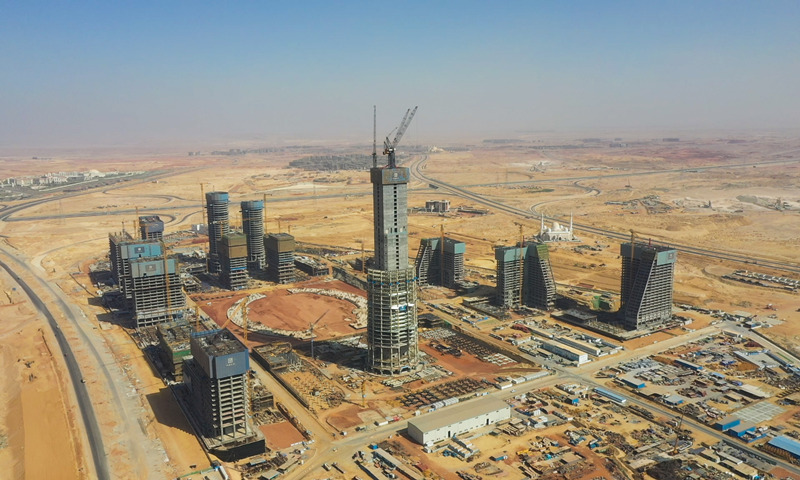
The base of the Iconic Tower CBD project in Cario Photo: Courtesy of China State Construction Engineering Corporation
Before she joined CSCEC, she wondered if she would be capable of taking the job and working with Chinese people. "Now CSCEC is my second home and my colleagues are my family," the 55-year-old said, noting that the Chinese company has given her more experience and independence and made her more ambitious and tough.In the video, Hanan shared a story about how the Chinese company has geared up development in her country. Constructed by CSCEC, a huge Central Business District (CBD) project in Cairo is seen as a landmark for the BRI that seeks win-win development cooperation between participating states through economic and trade partnerships as well as infrastructure projects.
The Iconic Tower's base required about 18,500 cubic meters of concrete and 5,000 tons of reinforced iron bars, all of which was poured into the site in one go in late February over a 38-hour non-stop period - an unprecedented process in Egypt's construction history.
"This is a good and huge project, which will encourage investment from all over the world to Egypt and improve the economy across a number of sectors," said Hanan.
She added that the BRI project could be described as "one road, one dream" for her, because it improves economic conditions in Egypt, as well as for her family.
Hanan said that since joining the company, she has also fallen in love with Chinese culture. "I like green tea. I love Spring Festival, and I love Chinese food, especially dumplings, Peking duck, chow mein and mapo tofu.
Spiritual house
Taking an active part in the BRI, Chinese state-owned enterprises have not only played a positive role in promoting infrastructure connectivity, enhancing international cooperation on production capacity, boosting local employment and promoting local economic and social development, but also in sharing a more complete picture of Chinese culture for others to gain a better understanding of China, enhancing cultural interaction and mutual understanding.
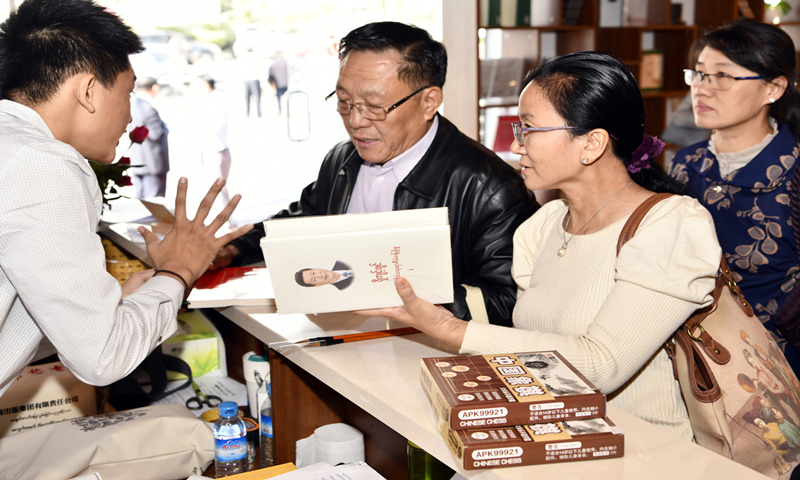
Residents in Mandalay buy a Burmese translation of the book Xi Jinping: The Governance of China at the Chinese nostalgia bookstore. Courtesy of Wu Junjun
Among the winners, a short video telling the story of a Chinese nostalgia bookstore in Myanmar and how it disseminates Chinese culture among local ethnic Chinese is just such an example.
Wu Junjun, the 27-year-old Chinese Burmese woman who runs the bookstore in Mandalay, told the Global Times in fluent Putonghua that since she was a child, she had heard a lot of stories about China from her parents that had ignited her curiosity about her home country.
In 2012, she decided to go back to China to get a closer look at her motherland, so she applied to study at a middle school and a university in Southwest China's Yunnan Province. After graduation, without hesitation, she joined the bookstore with the ambition to spread Chinese culture in Myanmar and promote friendship between the two countries.
According to Wu, local ethnic Chinese, as well as a number of Burmese, have strong enthusiasm for Chinese culture, economic development and political policies.
"For example, the Burmese translation of the book Xi Jinping: The Governance of China, is very popular among Chinese students as a good way to study the language, and allow locals that are keen on getting insights into China's political system to do so," Wu said.
The Chinese nostalgia bookstore in Mandalay is in fact part of a project called "the Nostalgia Academy," which was launched in Yunnan in 2017.
Zhao Qiongying, vice manager of overseas business division of the Yunnan Xinhua Bookstore Group Co that runs the project, told the Global Times on Saturday that the academy aims to become a spiritual home for overseas Chinese to express their nostalgia and enhance their sense of national identity.
"If you know where your hometown is, you should know what goes on there," Zhao said.
The academy has opened bookstores in Southeast Asian countries such as Laos, Myanmar and Thailand, and is expected to open more in South Asia, Zhao said, noting that as an important part of serving the BRI, it lays the groundwork for people to trace their Chinese roots and traditional culture.
The BRI Short Video Competition has served as a "bridge", connecting people and enhancing their friendships. It is expected that efforts will be made by more Chinese enterprises to build brands, shape cultures and display images to improve their soft power and capability of overseas communication, and contribute to the BRI construction.
Newspaper headline: Four portraits